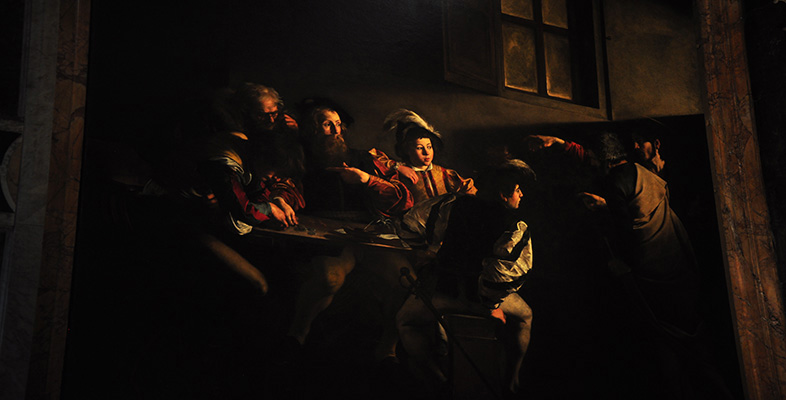1.4 The artist's ‘Life’ as a historical source
In the introduction to Caravaggio, and at different points in the book, Langdon discusses the comparative merits of different kinds of evidence. Her main form of evidence is textual rather than artistic, however. This is the key to the empirical method that she applies to her subject.
Activity 4
Helen Langdon emphasises the empirical nature of her method in constructing a biography of Caravaggio, preferring ‘as far as possible … seventeenth-century source material [over] twentieth-century myth and speculation’. In Chapter 3, ‘Flowers and Fruit’, she combines a variety of sources to recreate the earliest part of Caravaggio's career. Read the two seventeenth-century sources by Mancini and Bellori now (below) then read Chapter 3 again before answering the following questions.
Click to read the Mancini source [Tip: hold Ctrl and click a link to open it in a new tab. (Hide tip)] .
Click to read the Bellori source.
Langdon relies heavily on the early ‘lives’ of Caravaggio. Do you think these ‘Lives’ are primary or secondary sources? What are the advantages and disadvantages of using these ‘Lives’ as historical sources?
Discussion
The first of many ‘Lives’ of Caravaggio, Considerazioni sulla pittura (1617–21) was written by Giulio Mancini. It contains both primary and secondary information. Knowing a bit about Mancini helps: Mancini knew Caravaggio, so he provides in part an eye-witness account of the artist. As well as specific details about Caravaggio himself, Mancini also refers to some of the conventions of the day, such as the ‘appropriateness’ of depicting particular subjects in certain ways, and to attitudes to some of Caravaggio's paintings. This information is primary source material. When Mancini turns to defining the Roman school of painting he interprets the information he has and provides his own categories or conclusions based on it. Usefully, he often points to his interpretation of material by writing phrases like ‘it seems to me …’. This is secondary source material, though of a uniquely important kind because it was written so close to the time of the artist himself. Other sources that Langdon uses are more problematic. On page 55, for example, Langdon writes that Caravaggio arrived in Rome with no property or reputation. Bellori, writing in 1672, tells us this. Though early, this is a secondary source. Similarly Caravaggio's relationship with Mario Minniti, the Sicilian painter, comes from a 1724 source (p. 60). Although the Mancini and Bellori ‘Lives’ are seventeenth-century sources, they are themselves narrative constructions: they are not neutral primary sources. Bellori's was written some time after Caravaggio's death and yet what he writes is privileged in the way a primary source is.
A great deal of what seems to be reliable fact about Caravaggio is open to question and interpretation. Throughout her book, Helen Langdon turns to discussion of the veracity of different sources and adds circumstantial evidence about patrons and the wider cultural context to fill in gaps and confirm otherwise unreliable information about Caravaggio. In fact, few artists have surrounding them as much primary source material as art historians would like to be able to recreate their career or to reinterpret their works. With so few other sources surviving, artists' ‘Lives’ can and have taken on a significance and weight that they simply do not support or often deserve.
Part of the ‘confusion’ Soussloff refers to in Section 1.3 is the status of an artist's ‘Life’ as a source for other discussions of an artist's work. Are ‘Lives’ primary or secondary sources?
The pragmatist who seeks the individual in the ‘Life’ will, of necessity, be disappointed, although a desire to find the ‘individuality’ of the visual artist has led many to read the ‘Lives’ as primary documents.
(Soussloff, 1990, p. 162)
In Soussloff's book, The Absolute Artist (1997), the author develops her point about the problem that artists' ‘Lives’ create when used as a primary source. Indeed, ‘assumptions regarding the artist and work of art appropriated from the biographical literature have determined art history's view of these subjects and also of itself’ (Soussloff, 1997, p. 77). She notes, for example, that even Jacob Burckhardt's Civilization of the Renaissance in Italy (1860, English translation 1878) is based largely on artists' ‘Lives’ (though it is thematic rather than biographical in form). In this context, according to Soussloff, it is no wonder that Burckhardt is able to celebrate ‘The Development of the Individual’ as one of his sections.
Burckhardt's characterization of the civilization of the Renaissance in Italy relied on texts that were as concerned with individual personalities as they were with the works that those personalities produced. His Romantic strain was naturally attracted to the idea of the individual genius, a concept central to all German historicism of the nineteenth century …
The account of the artist and the works known as the biography of the artist has proven to be constitutive of itself in highly significant ways for art history writing. Perhaps this is because the genre mediates so well between the imaginary and the real, between the myth and the history, between the artist and the object … The nineteenth- and twentieth-century conception of the artist remains pegged to the fourteenth- and fifteenth-century concept on which it is uncritically based.
(Soussloff, 1997, pp. 87 and 93)
Activity 5
As a means of revising this course, answer the following question:
What do you think are the advantages and disadvantages of using artists' ‘Lives’ as sources for art historical study?
